Integrating IP Mobility Management Protocols and MANET: A Survey
Abstract
:1. Introduction
2. IP Mobility Management Protocols
2.1. Macro Mobility Management Solutions
2.2. Micro Mobility Management Solutions
3. MANET Routing Protocols
3.1. Reactive MANET Routing
3.2. Proactive MANET Routing
4. IP Mobility Management in MANET and Comparative Summary
4.1. Proactive Gateway Discovery-Based Mobility Management Solutions
4.2. Reactive Gateway Discovery-Based Mobility Management Solutions
4.3. Hybrid Gateway Discovery-Based Mobility Management Solutions
5. Conclusions
Funding
Acknowledgments
Conflicts of Interest
References
- Bruzgiene, R.; Narbutaite, L.; Adomkus, T. MANET Network in Internet of Things System; Ad Hoc Networks; IntechOpen: London, UK, 2017; pp. 89–114. [Google Scholar]
- Dai, H.N.; Zheng, Z.; Zhang, Y. Blockchain for Internet of Things: A Survey. IEEE Internet Things J. 2019, 6, 8076–8094. [Google Scholar] [CrossRef] [Green Version]
- Wu, Y.; Dai, H.N.; Wang, H.; Choo, K.K. Blockchain-Based Privacy Preservation for 5G-Enabled Drone Communications; IEEE Network: The Magazine of Global Information Exchange; Institute of Electrical and Electronics Engineers (IEEE): Piscatawa, NJ, USA, 2020. [Google Scholar]
- Yang, Y.; Hua, K. Emerging Technologies for 5G-Enabled Vehicular Networks. IEEE Access 2019, 7, 181117–181141. [Google Scholar] [CrossRef]
- Quy, V.K.; Ban, N.T.; Han, N.D. An advanced energy efficient and high performance routing protocol for MANET in 5G. J. Commun. 2018, 13, 743–749. [Google Scholar] [CrossRef]
- Hrabcak, D.; Dobos, L.; Papaj, J. The Concept of 2-Layer Routing for Wireless 5G Networks and Beyond. In Proceedings of the 29th International Conference, Radioelektronika (RADIOELEKTRONIKA), Pardubice, Czech Republic, 16–18 April 2019. [Google Scholar]
- Attia, R.; Rizk, R.; Ali, H.A. Internet connectivity for mobile ad hoc network: A survey based study. Wirel. Netw. 2015, 21, 2369–2394. [Google Scholar] [CrossRef]
- Kushwah, R.; Tapaswi, S.; Kumar, A. A detailed study on internet connectivity schemes for mobile ad hoc network. Wirel. Pers. Commun. 2019, 104, 1433–1471. [Google Scholar] [CrossRef]
- Bouaziz, M.; Rachedi, A. A survey on mobility management protocols in Wireless Sensor Networks based on 6LoWPAN technology. Comput. Commun. 2016, 74, 3–15. [Google Scholar] [CrossRef] [Green Version]
- Oliveira, L.M.; De Sousa, L.A.F.; Rodrigues, J.J.P.C. Routing and mobility approaches in IPv6 over LoWPAN mesh networks. Int. J. Commun. Syst. 2011, 24, 1445–1466. [Google Scholar] [CrossRef]
- Zhu, K.; Niyato, D.; Wang, P.; Hossain, E.; Kim, D.I. Mobility and handoff management in vehicular networks: A survey. Wirel. Commun. Mob. Comput. 2011, 11, 459–476. [Google Scholar] [CrossRef]
- Abduljalil, F.; Bodhe, S. A survey of integrating IP mobility protocols and mobile ad hoc networks. IEEE Commun. Surv. Tutor. 2007, 9, 14–30. [Google Scholar] [CrossRef]
- Soliman, H.; Castelluccia, C.; El Malki, K.; Bellier, L. Hierarchical Mobile IPv6 Mobility Management (HMIPv6); RFC 4140; IETF: Fremont, CA, USA, 2005; Available online: https://tools.ietf.org/html/rfc4140 (accessed on 10 July 2020).
- Lee, J.; Bonnin, J.; Member, S.; You, I. Comparative handover performance analysis of IPv6 mobility management protocols. IEEE Trans. Ind. Electron. 2013, 60, 1077–1088. [Google Scholar]
- Dong, P.; Zhang, H.; Luo, H.; Chi, T.; Kuo, S. A network-based mobility management scheme for future Internet. Comput. Electr. Eng. 2010, 36, 291–302. [Google Scholar] [CrossRef]
- Liu, D.; Chan, H. Distributed Mobility Management: Current Practices and Gap Analysis; RFC 7429; IETF DMM Working Group: Fremont, CA, USA, 2015. [Google Scholar]
- Perkins, C. Mobile IP Design Principles and Practices; Addison Wesley: New York, NY, USA, 1998. [Google Scholar]
- Ramjee, R.; Varadhan, K.; Salgarelli, L.; Thuel, S.; Wang, S.Y.; La Porta, T. HAWAII: A Domain-based Approach for Supporting Mobility in Wide-area Wireless networks. IEEE-ACM Trans. Netw. 2002, 10, 396–410. [Google Scholar] [CrossRef]
- Valk, A.G. Cellular IP: A new approach to internet host mobility. ACM SIGCOMM Comput. Commun. 1999, 29, 50–65. [Google Scholar] [CrossRef]
- Jabbar, W.A.; Ismail, M.; Nordin, R.; Arif, S. Power-efficient routing schemes for MANETs: A survey and open issues. Wirel. Netw. 2017, 23, 1917–1952. [Google Scholar] [CrossRef]
- Walikar, G.A.; Biradar, R.C. A survey on hybrid routing mechanisms in mobile ad hoc networks. J. Netw. Comput. Appl. 2017, 77, 48–63. [Google Scholar] [CrossRef]
- Akhtar, N.; Khattak, M.A.K.; Ullah, A.; Javed, M.Y. Congestion aware and adaptive routing protocols for MANETs: A survey. In Recent Trends and Advances in Wireless and IoT-Enabled Networks; Khan, M., Alam, F.M., Eds.; Springer: Cham, Switzerland, 2019; pp. 159–169. [Google Scholar]
- Zhang, H.; Wang, X.; Memarmoshrefi, P.; Hogrefe, D. A survey of ant colony optimization based routing protocols for mobile ad hoc networks. IEEE Access 2017, 5, 24139–24161. [Google Scholar] [CrossRef]
- Alotaibi, E.; Mukherjee, B. A survey on routing algorithms for wireless ad-hoc and mesh networks. Comput. Netw. 2012, 56, 940–965. [Google Scholar] [CrossRef]
- Al Mojamed, M.; Kolberg, M. Structured peer-to-peer overlay deployment on MANET: A survey. Comput. Netw. 2016, 96, 29–47. [Google Scholar] [CrossRef]
- Perkins, C.; Belding-Royer, E.; Das, S. Ad Hoc on-Demand Distance Vector (AODV) Routing; RFC: 3561; IETF: Fremont, CA, USA, 2003; Available online: https://tools.ietf.org/html/rfc3561 (accessed on 10 July 2020).
- Perkins, C.; Ratliff, S.; Dowdell, J. Dynamic MANET on-Demand (DYMO) Routing. 2009. Available online: https://tools.ietf.org/html/draft-ietf-manet-dymo-17 (accessed on 10 July 2020).
- Johnson, D.; Hu, Y.; Maltz, D. The Dynamic Source Routing Protocol (DSR) for Mobile Ad Hoc Networks for IPv4; RFC: 4728; IETF: Fremont, CA, USA, 2007; Available online: https://tools.ietf.org/html/rfc4728 (accessed on 25 May 2020).
- Park, V.; Corson, S. Temporally-Ordered Routing Algorithm (TORA). 2001. Available online: https://tools.ietf.org/id/draft-ietf-manet-tora-spec-04.txt (accessed on 25 May 2020).
- Perkins, C.E.; Bhagwat, P. Highly dynamic destination-sequenced distance-vector routing (DSDV) for mobile computers. ACM SIGCOMM Comput. Commun. 1994, 24, 234–244. [Google Scholar] [CrossRef]
- Clausen, T.; Jacquet, P. Optimized Link State Routing Protocol (OLSR); RFC 3626; IETF: Fremont, CA, USA, 2003; Available online: https://tools.ietf.org/html/rfc3626 (accessed on 25 May 2020).
- Murthy, S.; Garcia-Luna-Aceves, J.J. An efficient routing protocol for wireless networks. Mob. Netw. Appl. Spec. Issue Routing Mob. Commun. Netw. 1996, 1, 183–197. [Google Scholar] [CrossRef] [Green Version]
- Neumann, A.; Aichele, C.; Lindner, M.; Wunderlich, S. Better Approach to Mobile Ad-Hoc Networking (BATMAN); IETF Draft; IETF: Fremont, CA, USA, 2008. [Google Scholar]
- Garcia-Luna-Aceves, J.; Spohn, M. Source-tree routing in wireless networks. In Proceedings of the 7th International Conference on Network Protocols, Toronto, ON, Canada, 31 October–3 November 1999; pp. 273–282. [Google Scholar]
- Ofosu, K.K.; Abdulai, J.-D.; Katsriku, F.A. Performance evaluation of Mobile IP on mobile ad hoc networks using NS2. In Proceedings of the 8th International Conference on Computer Science, Engineering and Applications, Sydney, Australia, 22–23 December 2018; pp. 15–27. [Google Scholar]
- Alsaied, E.; Modatheir, S. Performance evaluation of Mobile IP with DSDV routing protocol using NS2. In Proceedings of the International Conference on Computing, Control, Networking, Electronics and Embedded Systems Engineering, Khartoum, Sudan, 7–9 September 2015; pp. 308–313. [Google Scholar]
- Khan, K.U.; Reddy, A.V.; Zaman, R.U. An efficient integrated routing protocol for interconnecting mobile ad hoc networks and the internet. In Proceedings of the International Conference on Advances in Computing, Communication and Control, Mumbai, India, 23–24 January 2009; pp. 460–466. [Google Scholar]
- Khan, K.; Reddy, A.V.; Zaman, R.U. An efficient integrated routing protocol for interconnecting mobile ad hoc network and the internet. Int. J. Comput. Electr. Eng. 2009, 1, 32. [Google Scholar] [CrossRef] [Green Version]
- Khan, K.U.R.; Reddy, K.A.; Reddy, A.V.; Zaman, R.U.; Harsha, T.S. An efficient DSDV routing protocol for MANET and its usefulness for providing internet access to ad hoc hosts. In Proceedings of the IEEE Region 10th Conference, Hyderabad, India, 19–21 November 2008. [Google Scholar]
- Hamad, H.; Abudalfa, S.; Sahmoud, S. Adaptive mobility management scheme for Mobile IP using ad hoc networks. Int. Arab J. Inf. Technol. 2011, 2, 65–71. [Google Scholar]
- Ding, S. Thorough protocol extensions for integrating DSR-based Mobile Ad Hoc Networks with the Internet. Wirel. Commun. Mob. Com. 2010, 10, 1391–1408. [Google Scholar] [CrossRef]
- Wang, C.; Li, C.; Hwang, R.; Chen, Y. Global connectivity for Mobile IPv6-based ad hoc networks. In Proceedings of the 19th International Conference on Advanced Information Networking and Applications, Taipei, Taiwan, 25–30 March 2005. [Google Scholar]
- Benzaid, M.; Minet, P.; Al Agha, K.; Adjih, C.; Allard, G. Integration of mobile-IP and OLSR for a universal mobility. Wirel. Netw. 2004, 10, 377–388. [Google Scholar] [CrossRef]
- Jung, J.; Montgomery, D.; Lim, K.; Kahng, H. Dynamic agent advertisement of mobile ip to provide connectivity between ad hoc networks and internet. In Proceedings of the Information Networking, Networking Technologies for Broadband and Mobile Networks, International Conference ICOIN 2004, Busan, Korea, 18–20 February 2004; pp. 277–286. [Google Scholar]
- Hoang, V.D.; Shao, Z.; Fujise, M.; Nguyen, H.M. A novel solution for global connectivity in MANET. In Proceedings of the IEEE 60th Vehicular Technology Conference, Los Angeles, CA, USA, 26–29 September 2004; pp. 2819–2823. [Google Scholar]
- Ergen, M.; Puri, A. MEWLANA-Mobile IP enriched wireless local area network architecture. In Proceedings of the IEEE 56th Vehicular Technology Conference, Vancouver, BC, Canada, 24–28 September 2002; pp. 2449–2453. [Google Scholar]
- Jonsson, U.; Alriksson, F.; Larsson, T.; Johansson, P.; Gerald, J. MIPMANET—Mobile IP for Mobile Ad Hoc Networks. In 1st ACM International Symposium on Mobile ad Hoc Networking & Computing; ACM, Inc.: New York, NY, USA, 2000; pp. 75–85. [Google Scholar]
- Ratanchandani, P.; Kravets, R. A hybrid approach to internet connectivity for mobile ad hoc networks. IEEE Wirel. Commun. Netw. 2003, 3, 1522–1527. [Google Scholar]
- Yan, Y.; Ci, L.; Wang, Z.; He, W. QoS-based Gateway Selection in MANET with Internet Connectivity. In Proceedings of the International Conference on Advanced Communications Technology, Ho Chi Minh, Vietnam, 16–18 October 2013; pp. 195–199. [Google Scholar]
- Nordström, E.; Gunningberg, P.; Tschudin, C. Robust and flexible internet connectivity for mobile ad hoc networks. Ad Hoc Netw. 2011, 9, 1–15. [Google Scholar] [CrossRef]
- Bo, L.; Bin, Y.; Bin, S. Adaptive discovery of internet gateways in mobile ad hoc networks with Mobile IP-based internet connectivity. In Proceedings of the 5th International Conference on Wireless Communications, Networking and Mobile Computing, Beijing, China, 24–26 September 2009. [Google Scholar]
- Huq, S.M.; Atiquzzaman, M.; Gruenwald, L. Internet Connectivity for IPv6-Based Mobile Ad Hoc Networks Using Cross-Layer Approach. Ph.D. Thesis, University of Oklahoma, Norman, OK, USA, 2010. [Google Scholar]
- Ammari, H.; El-Rewini, H. Integration of mobile ad hoc networks and the internet using mobile gateways. In Proceedings of the 18th International Parallel and Distributed Processing Symposium, Santa Fe, NM, USA, 26–30 April 2004. [Google Scholar]
- Shin, J.; Na, J.; Lee, H.; Park, A.; Kim, S. Mobile IP support in ad hoc networks with wireless backbone. In Proceedings of the IEEE 59th Vehicular Technology Conference, Milan, Italy, 17–19 May 2004; pp. 2136–2139. [Google Scholar]
- Tseng, Y.C.; Shen, C.C.; Chen, W.T. Integrating mobile IP with ad hoc networks. Computer 2003, 36, 48–55. [Google Scholar] [CrossRef]
- Sun, Y.; Belding-Royer, E.M.; Perkins, C.E. Internet connectivity for ad hoc mobile networks. Int. J. Wirel. Inf. Netw. 2002, 9, 75–88. [Google Scholar] [CrossRef]
- Denko, M.K. Mobility management in hybrid ad-hoc networks and the internet environment. Concurr. Comput.-Pract. E 2007, 18, 1193–1206. [Google Scholar] [CrossRef]
- Denko, M.K. A mobility management scheme for hybrid wired and wireless networks. In Proceedings of the 20th International Conference on Advanced Information Networking and Applications, Vienna, Austria, 18–20 April 2006; pp. 1–5. [Google Scholar]
- Bin, Y.; Bin, S. Modify AODV for MANET/INTERNET connection through multiple mobile gateways. In Proceedings of the11th International Conference on Advanced Communication Technology, Phoenix Park, Korea, 15–18 February 2009; Volume 3, pp. 1519–1523. [Google Scholar]

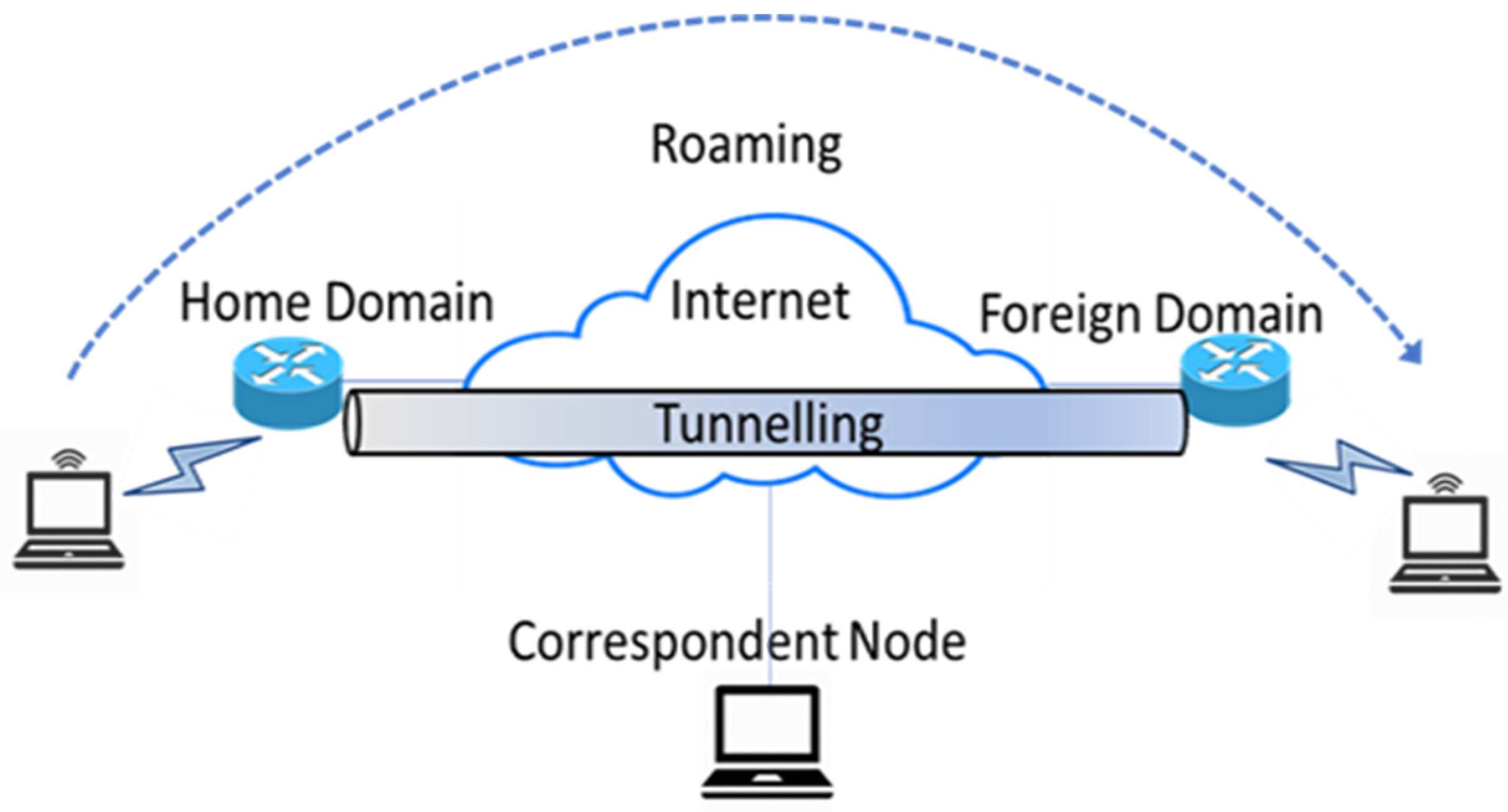
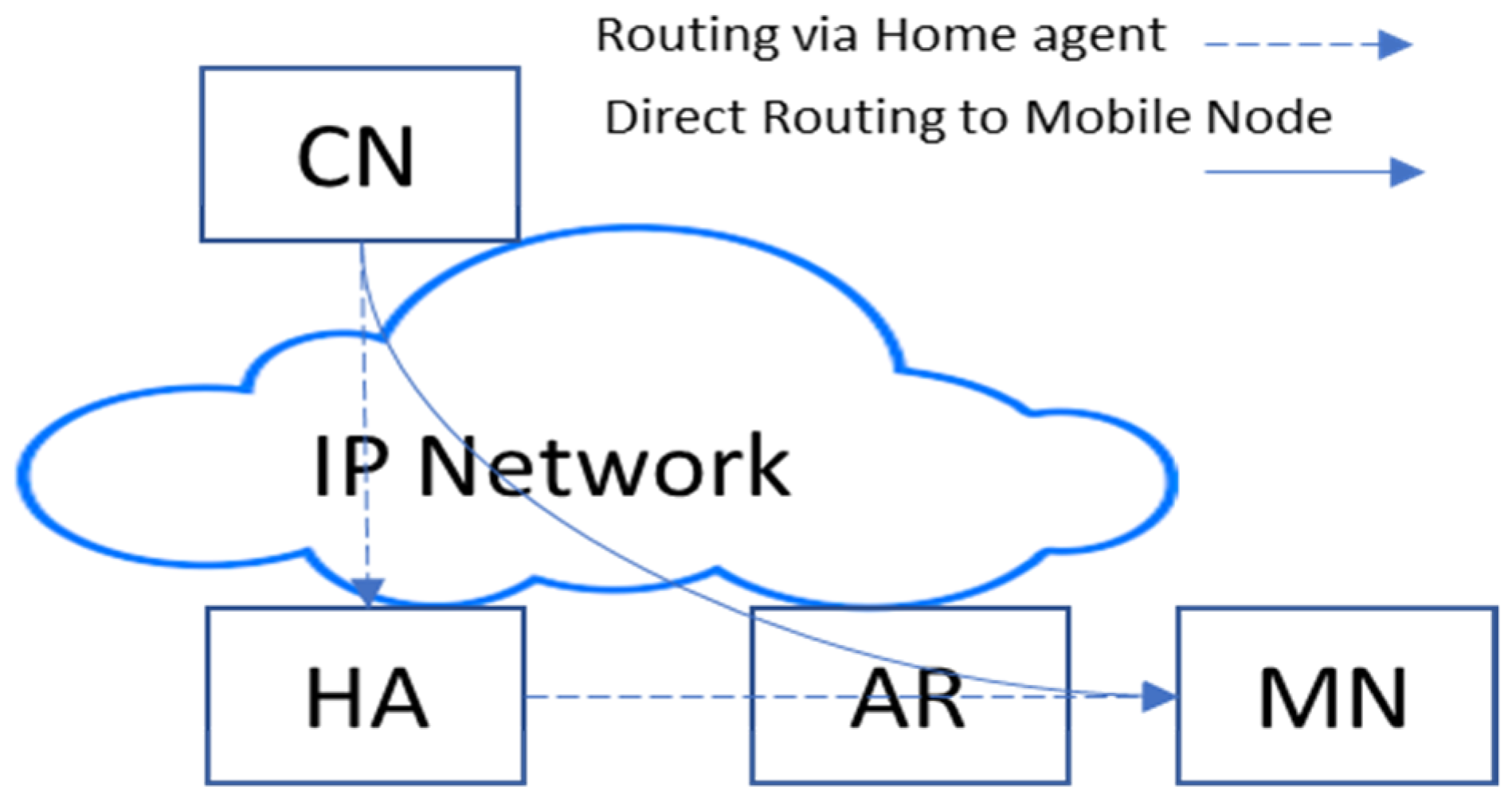
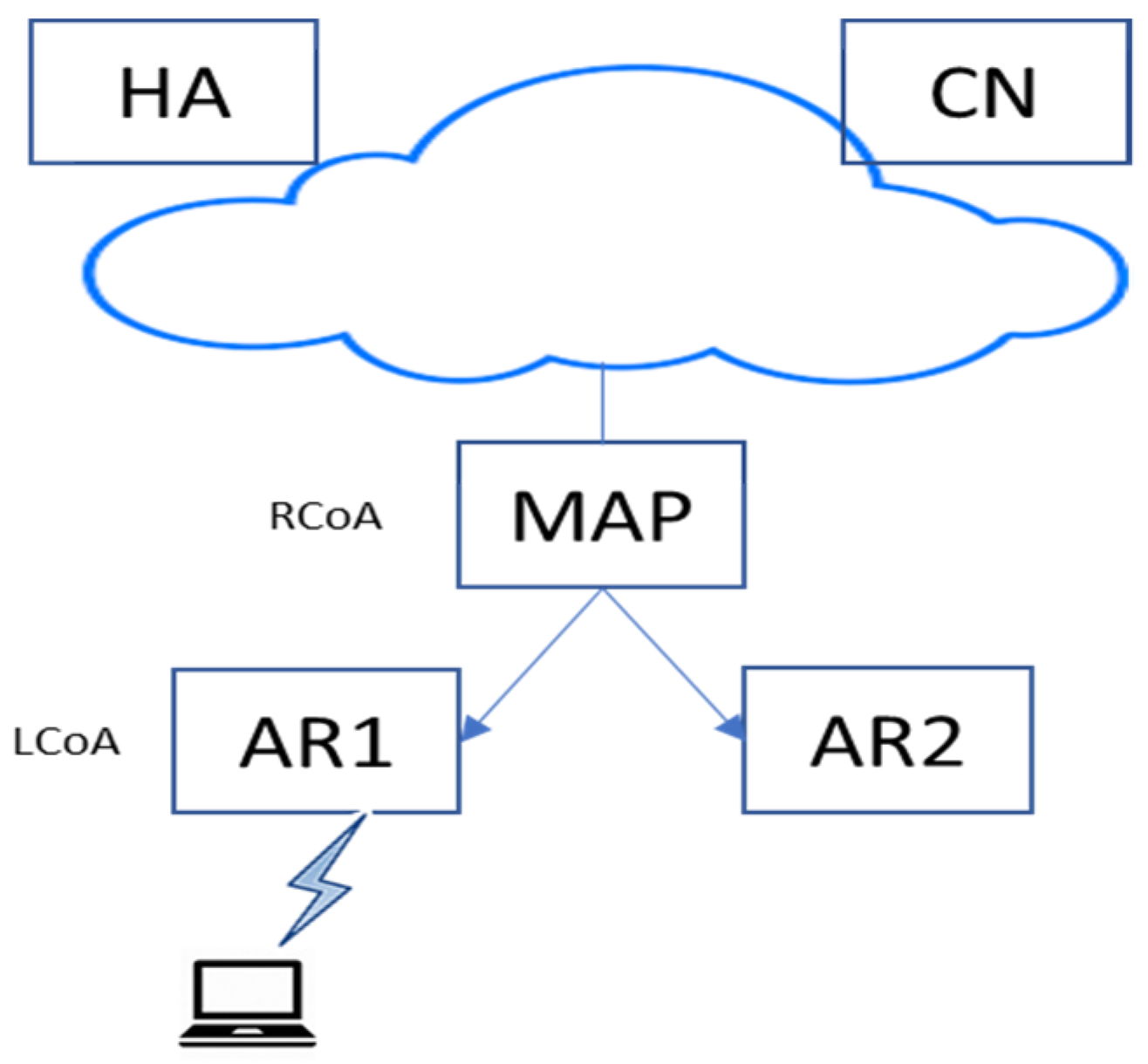
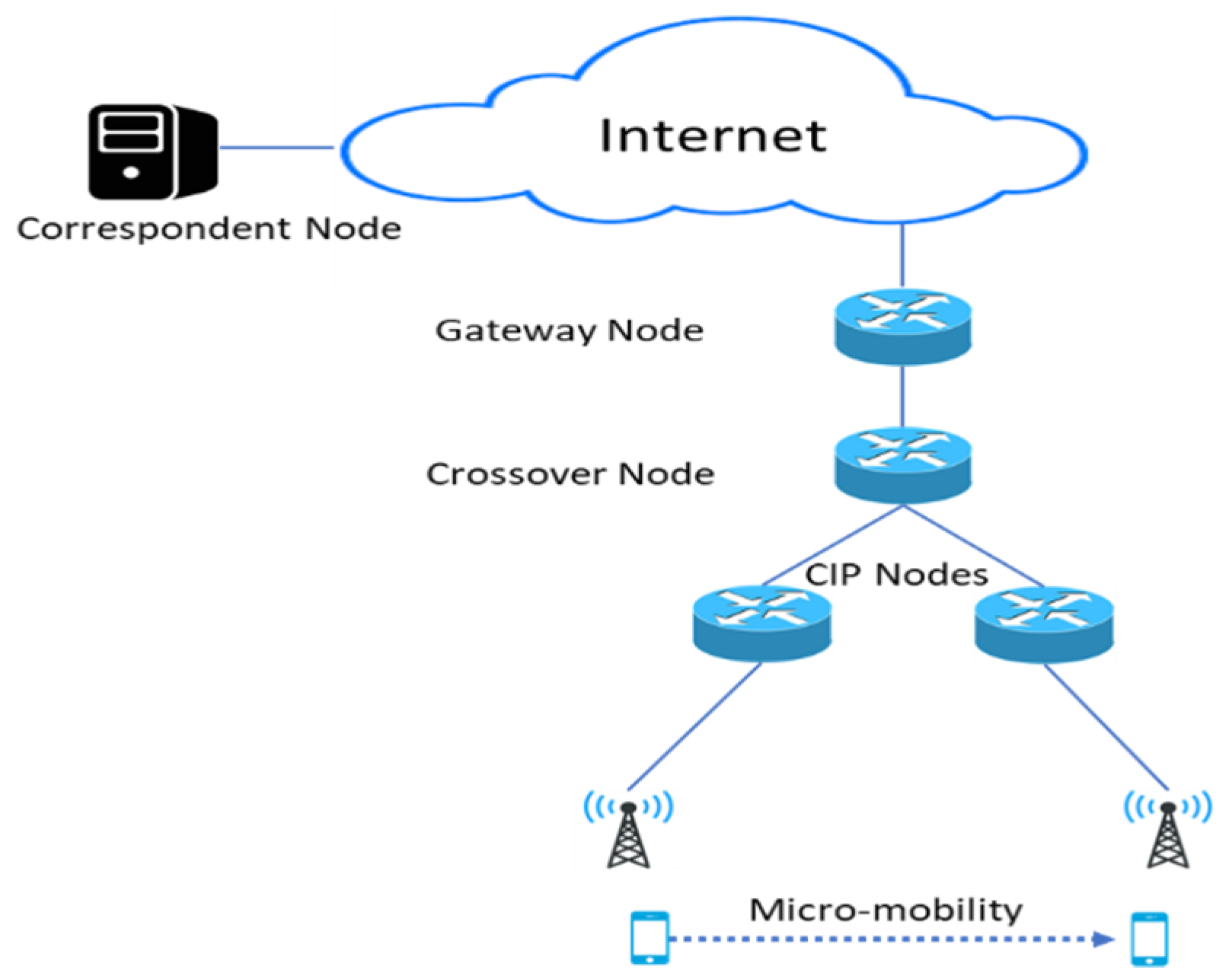
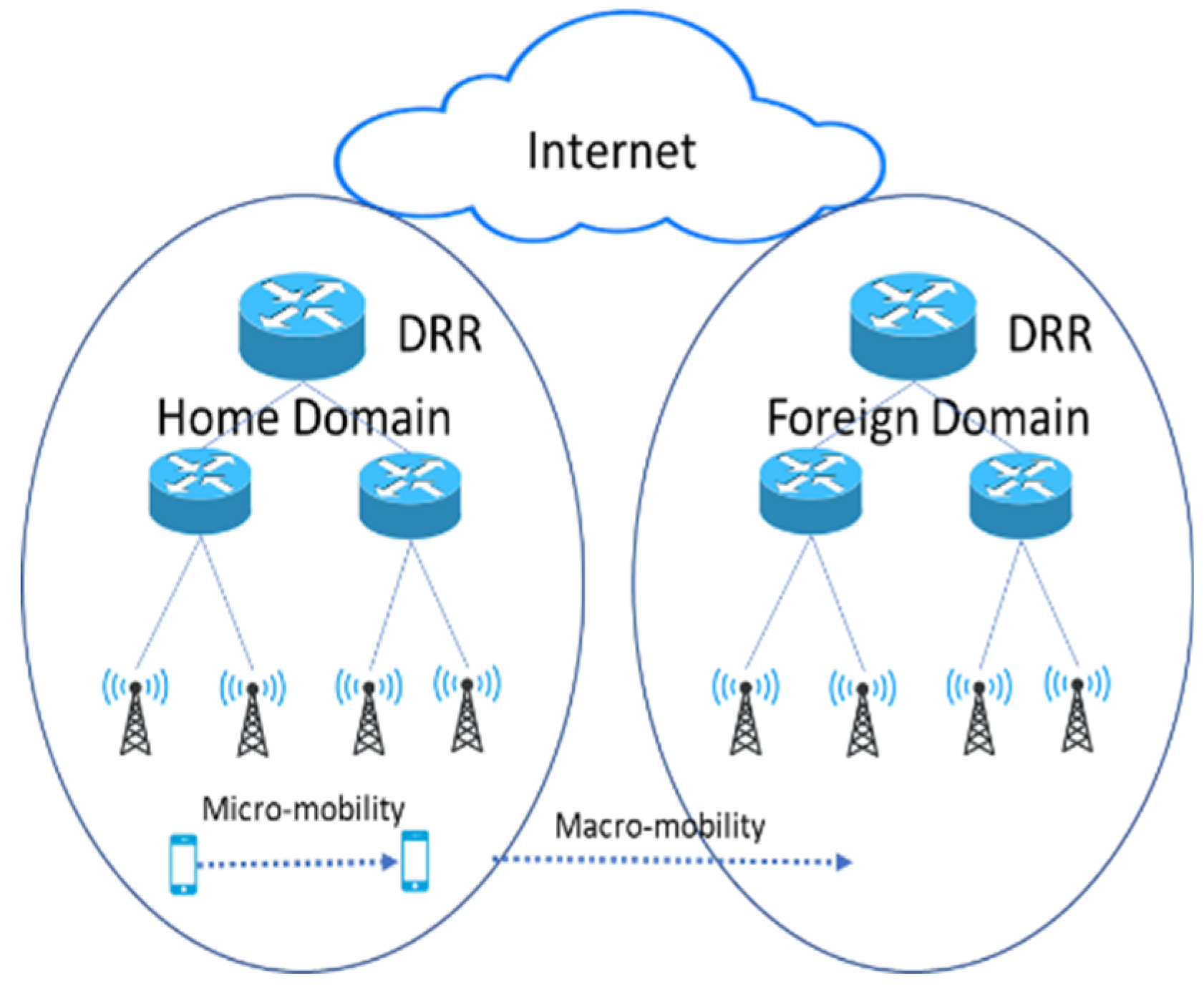
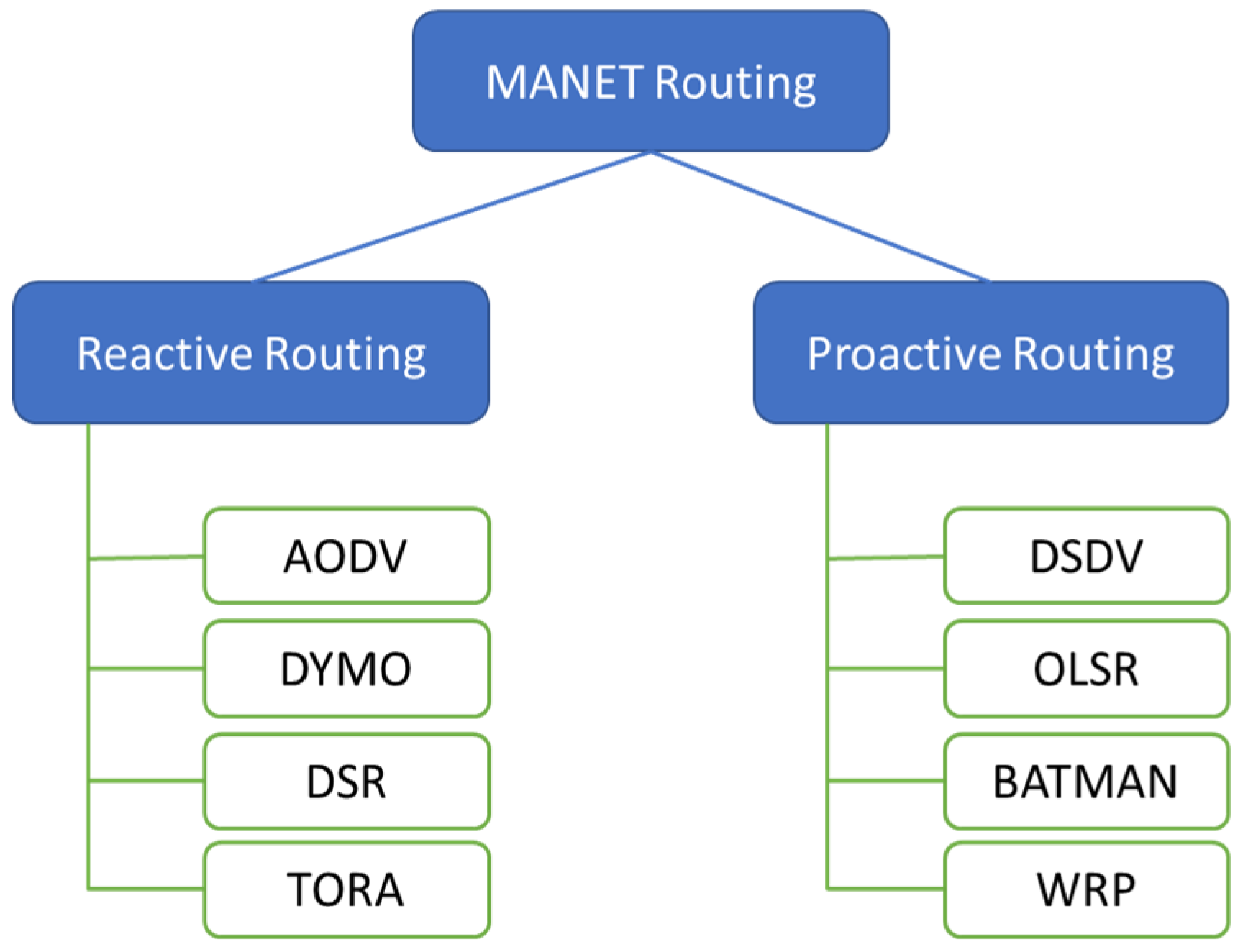
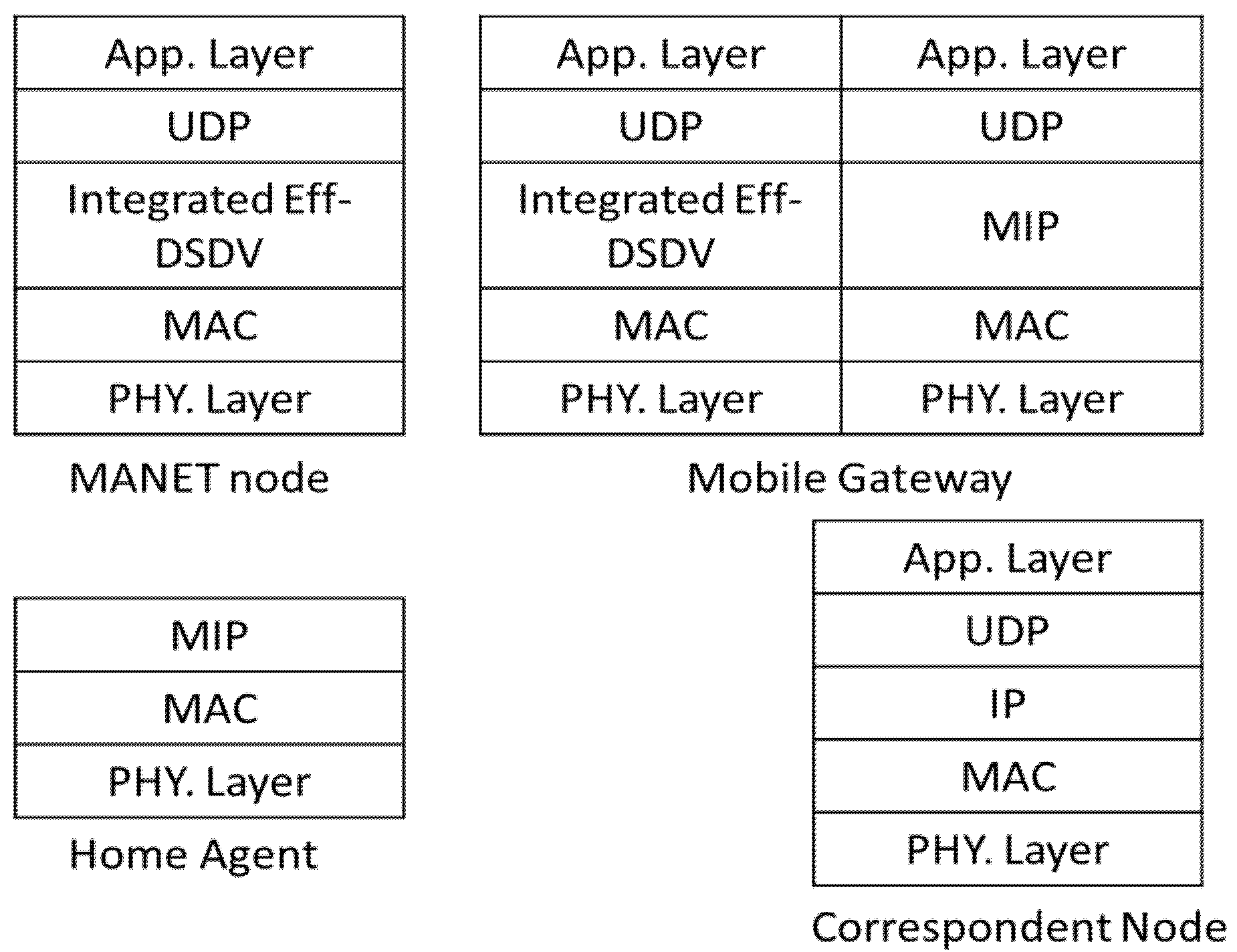
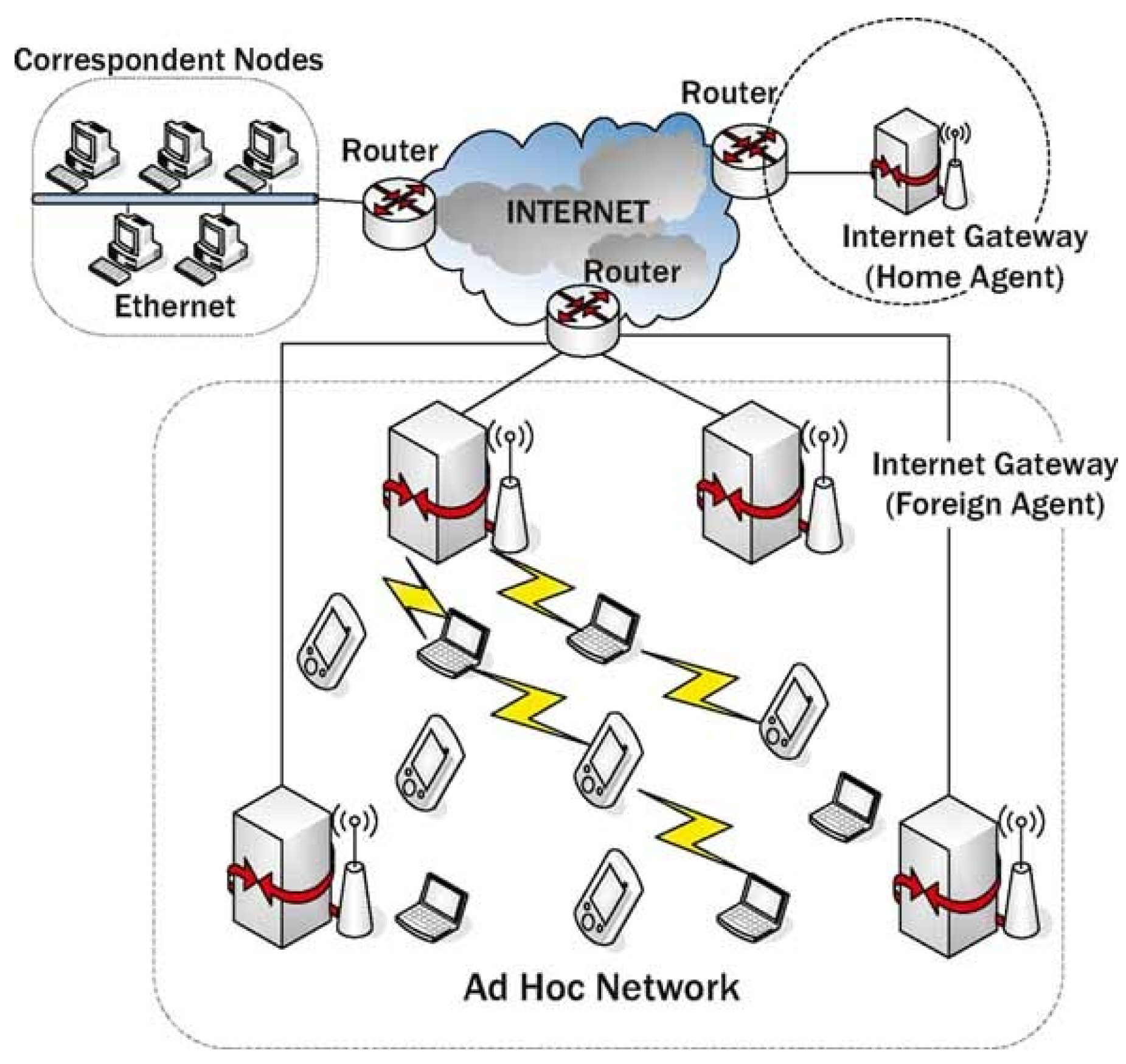
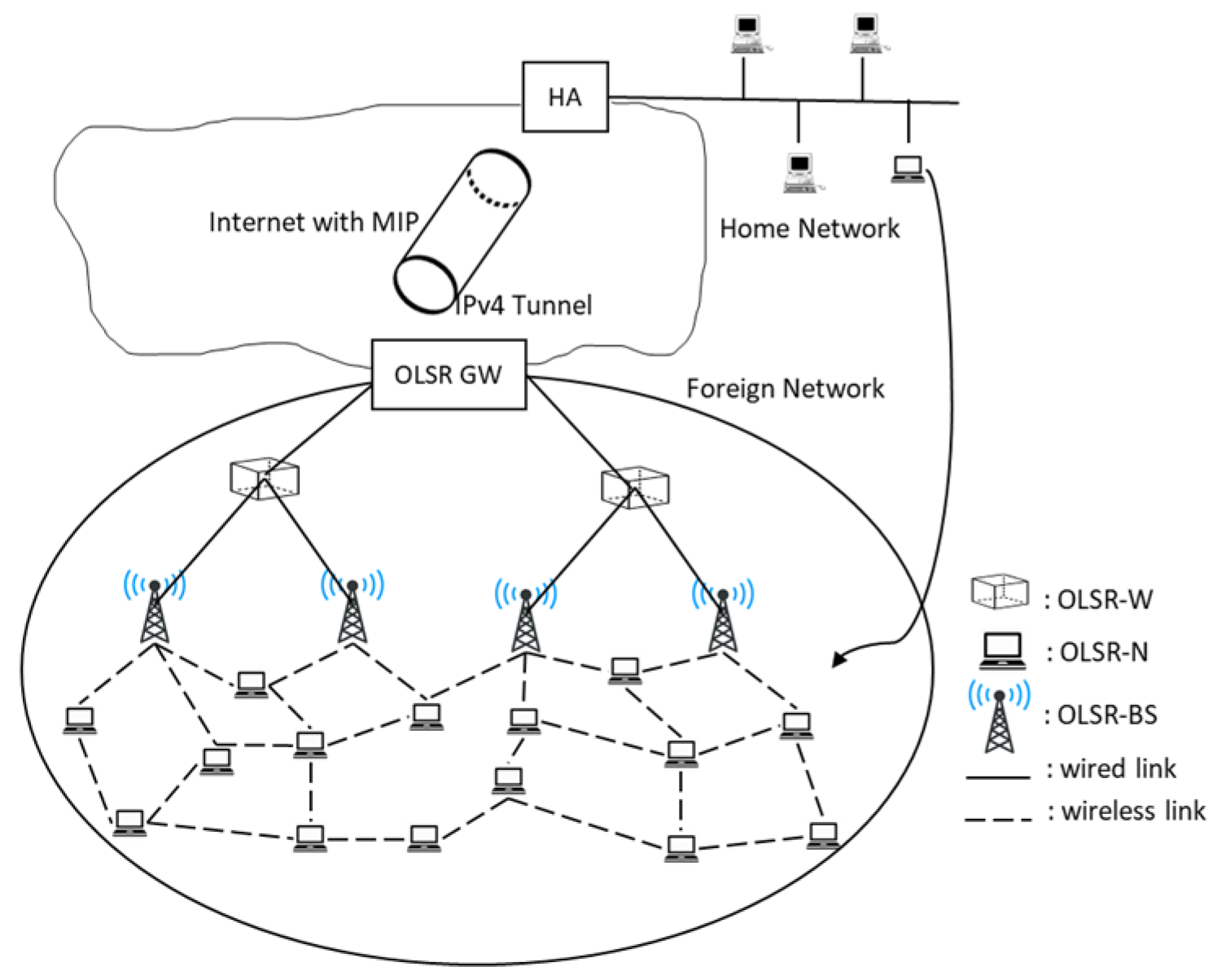
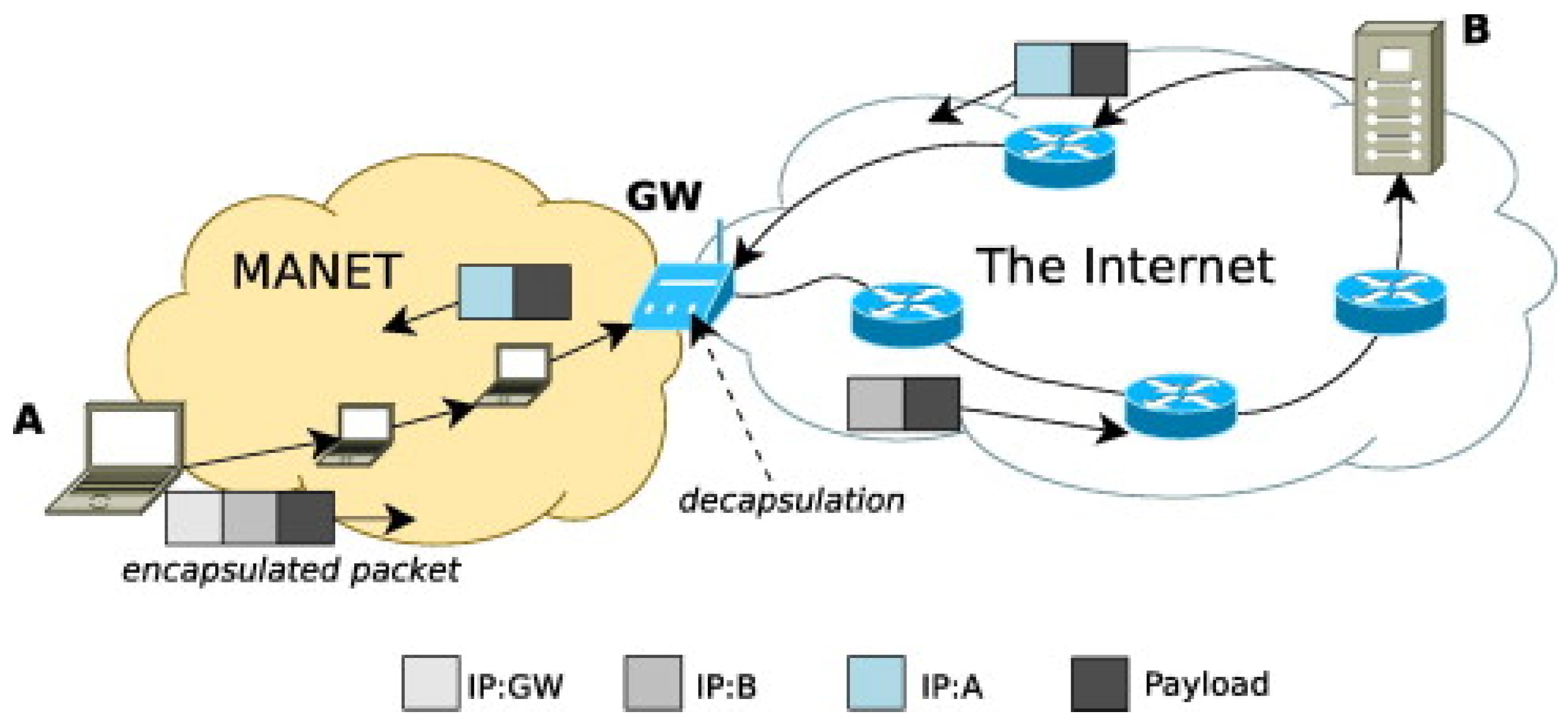

| Scheme | Features | Mobility Scheme | MANET Routing | Handoff Metrics | Gateways | Evaluation\Simulation |
|---|---|---|---|---|---|---|
| Ofosu et al. [35] | No modification to MIP. | MIPv4 | AODV- AOMDV- DSDV | - | 4 foreign agents | Evaluated using NS2, 175 nodes. |
| Alsaied and Modatheir [36] | No modification to MIP. | MIPv4 | DSDV | - | 3 routers covering 4 fixed foreign agents. | Evaluated using NS2 - 1, 5, 10, 15, 20 and 25 nodes. |
| Khan et al. [37] | Uses route update message to propagate gateway existence. Gateway acts as foreign agent | MIPv4 | Eff- DSDV | Gateway sends De-registration message to HA when the route entry to a node is lost. | 1 gateway | Evaluated using NCTUns simulator, 20 nodes, compared to [48]. |
| MIPAD [40] | Divides network into service subnets, each is covered by an access router. A mobile node with high mobility will not register with a new router, stays with old router to reduce signaling. | MIPv6 | AODV | Registration cost with HA and FA, hop counts, residence time, traffic and packet arrival rate. | 2 access routers as gateways. | Simulated in NS2, 2 access router and 1 mobile node moving between the service regions, compared to Hierarchical MIP. |
| Ding [41] | DSR routing message is piggybacked with MIP signaling message. Designs comprehensive external route judgment to judge locality of a destination. | MIPv4 | DSR | Hop counts | 4 gateways | Simulated in OPNET, 100 nodes, 10 are mobile nodes. Compared to another version of the system that uses traditional external route construction. |
| Wang et al. [42] | No modification to MIP. | MIPv6 | Proposes routing protocol uses tree topology, longest prefix matching. | - | 1 access router | Five notebooks were used, one is the access router and other acts as mobile nodes. |
| Benzaid et al. [43] | Uses hierarchical structure consisting of 3 levels. MIP is used to support macro mobility and OLSR for micro mobility. MPR Nodes rebroadcast any received agent advertisement message. | MIPv4 | OLSR | Hop count | 3 access routers linked to another router which is one step up in the hierarchy. | Testbed of 3 MANETs, each has one mobile node and managed by an access router known as OLSR-GW. |
| Jung et al. [44] | Gateway broadcasts 2 types of advertisement message; one with one hop lifetime and the other with 200 hops and 300 s lifetime. Extends RREP of AODV carries gateway information. | MIP | AODV | Hop count | 2 gateways | 2 MANET simulated in NS2, each has 4 mobile nodes. |
| MARs [45] | Relies on mobility anchor point that serves several access routers. Registration with 2 access routers is required. | Hierarchical MIP | DSDV-AODV | Hop count | 2 access routers belonging to one MAP. | Simulated in NS2, one MAP, 2 access routers, each serves 5 nodes. No simulation for the HMIP. 50 nodes in another scenario. |
| MEWLANA -TD [46] | Dynamic beaconing (MIP initiates beaconing if there is a node joining a network). Registration is required after each beacon. Uses tunneling. | MIP | DSDV | Hop count | Not specified | Simulated in NS2, 4, 8, 32, 64 and 128 having 1-10 traffic sources. Both were compared to MIPMANET. |
| MEWLANA -RD [46] | Formation of routing table is based on MIP entities. Constructs tree topology. Uses tunneling. | MIP | TBBR | Depth level number | Not specified. | |
| MIPMANET [47] | Access point acts as FA. Broadcast advertisement every 5s. FA is used as a default route. | MIP | AODV | Hop count (2 hops closer) | 2 foreign agents | Simulated in NS2, 15 mobile nodes. Compared to another version that does not broadcast advertisement message. |
| Scheme | Features | Mobility Scheme | MANET Routing | Handoff Metrics | Gateways | Evaluation\Simulation |
|---|---|---|---|---|---|---|
| Yan et al. [49] | Use simple additive weighting technique to calculate QoS. Solicitation message is broadcast by nodes to discover gateways. | MIPv4 | AODV | Traffic load, path quality and hop count. | 5 gateways | Simulated in NS2, 50 nodes, 15 are traffic sources, compared to variants of the system: minimal hops selection based, traffic selection based and path quality based. |
| Nordstorm et al. [50] | Eliminates gateway advertisement from Mobile IP. Extends AODV Route discovery for gateway discovery. | Mobile IPv4 | AODV | - | 2 gateways | 20 nodes simulated in NS2. Two variants of the system were compared; one uses tunneling and the other uses a default route forwarding strategy. It also implements a testbed consisting of 7 mobile nodes. |
| Bo et al. [51] | No gateway advertisement in MIP and assigns it to mobile nodes by broadcasting route request message to discover gateway. | MIP | AODV | Number of registered nodes with a gateway and hop count. | 3, 4, 5, 6 and 7 gateways | 30 nodes simulated in NS2, compared to traditional MIP over AODV and modified OLSR. |
| CATBR [52] | No gateway registration. Hierarchical routing to deliver data to internet. Cross-layering between link and network layers to enhance congestion awareness. | MIPv6 | Modified TBR | Contention metric, queue metric, self-metric and congestion along the path. | Not specified | Simulated in NS2, 10-50 nodes, compared to integration based on DSDV and TBR. |
| Ammari and El-rewini [53] | Gateways differ from foreign agent. Requires node registration with gateway. Requires registration with foreign agents. | MIP | DSDV | Hop count and load, metrics are applied for gateway selection and for foreign agent selection. | 2 foreign agents. 1-12 gateways | Simulated in NS2, 20 and 50 nodes. Number of mobile nodes connecting to the internet is 1,3 and 5 only, evaluated with different number of sources. No comparison to other systems. |
| Scheme | Features | Mobility Scheme | MANET Routing | Handoff Metrics | Gateways | Evaluation\Simulation |
|---|---|---|---|---|---|---|
| Shin et al. [54] | Agent advertisement broadcasting is limited. Uses gateway caching and proxy route reply. Uses tunneling. | MIPv4 | Reactive MANET (not specified) | - | - | Not evaluated |
| Tseng et al. [55] | Gateway advertisement is associated with a parameter to limit its scope. Uses tunneling. | MIPv4 | DSDV | Hop count | Not specified | Prototyped but not evaluated. |
| Ratanchandani and Kravets [48] | Based on limiting the propagation of gateway advertisement. Uses the ring search method when broadcasting solicitation. | MIP | AODV | Hop counts | 2 | Simulated in NS2, 50 and 100 nodes, evaluated by varying mobility speed and TTL. |
| Sun et al. [56] | Nodes broadcast a route request with agent multicast group address destination. Uses cell switching algorithm for mobility management. | MIP | AODV | Hop count (3 hops closer to the new gateway). | 1,2 | Simulated in NS2, 10-20-50 nodes, 5 are sources, evaluated with different numbers of gateways and nodes. |
| Denko [57] | Employed distributed buffer management approach in foreign agent and gateways. Proposed force handover, optimized handover and handover with prediction. | MIP | Not specified | Hop count and predicted gateway’s signal strength. | 2 gateways for each MANET | Simulated in NS2, 4 FA for 4 MANETs, each MANET has 50 nodes, evaluate the 3 handover mechanisms. |
| MG-AODV [59] | Replaced MIP advertisement by modified hello message. Uses conditional registration renewal mechanism based on broken route. | MIP | AODV | Hop count and gateway payload | Up to 6 gateways | Simulated in NS2, 30 nodes, compared its performance to [48]. |
© 2020 by the author. Licensee MDPI, Basel, Switzerland. This article is an open access article distributed under the terms and conditions of the Creative Commons Attribution (CC BY) license (http://creativecommons.org/licenses/by/4.0/).
Share and Cite
Al mojamed, M. Integrating IP Mobility Management Protocols and MANET: A Survey. Future Internet 2020, 12, 150. https://doi.org/10.3390/fi12090150
Al mojamed M. Integrating IP Mobility Management Protocols and MANET: A Survey. Future Internet. 2020; 12(9):150. https://doi.org/10.3390/fi12090150
Chicago/Turabian StyleAl mojamed, Mohammad. 2020. "Integrating IP Mobility Management Protocols and MANET: A Survey" Future Internet 12, no. 9: 150. https://doi.org/10.3390/fi12090150
APA StyleAl mojamed, M. (2020). Integrating IP Mobility Management Protocols and MANET: A Survey. Future Internet, 12(9), 150. https://doi.org/10.3390/fi12090150





